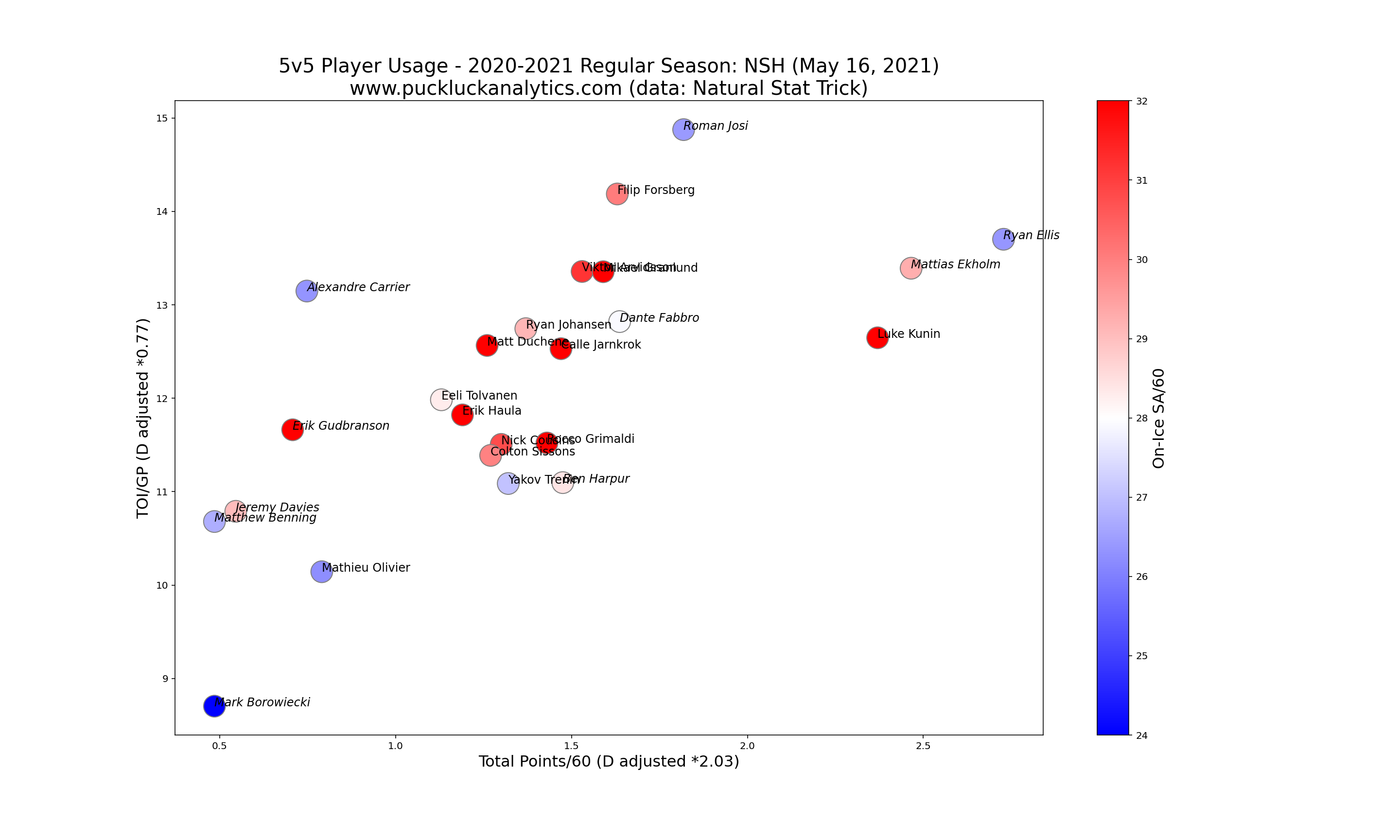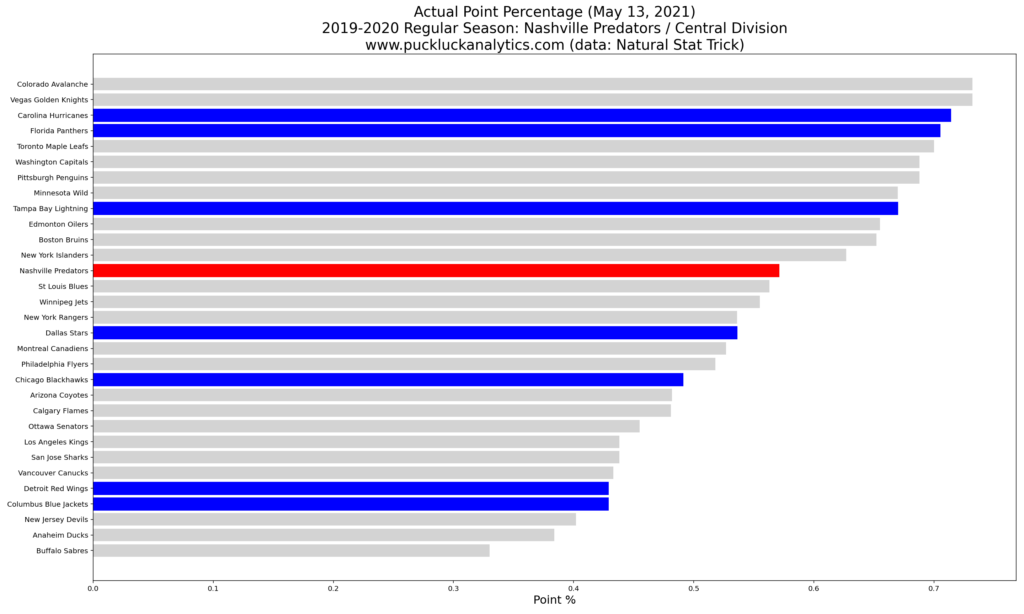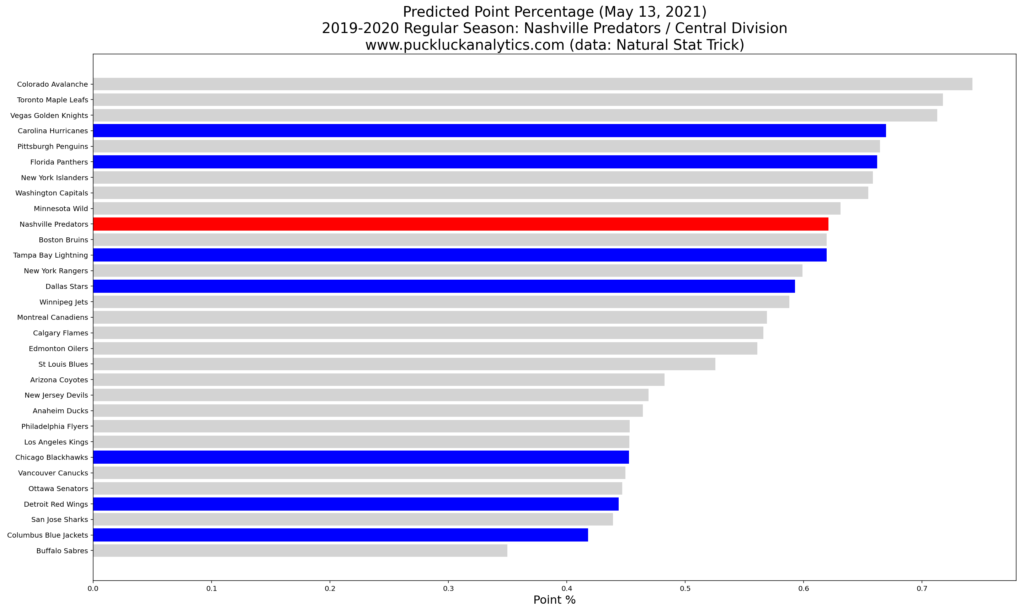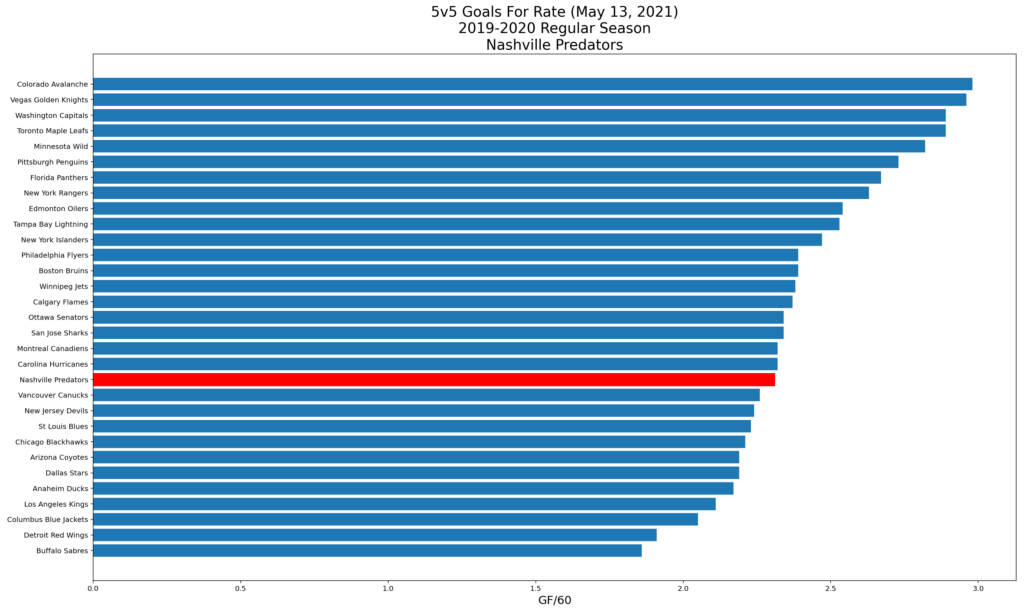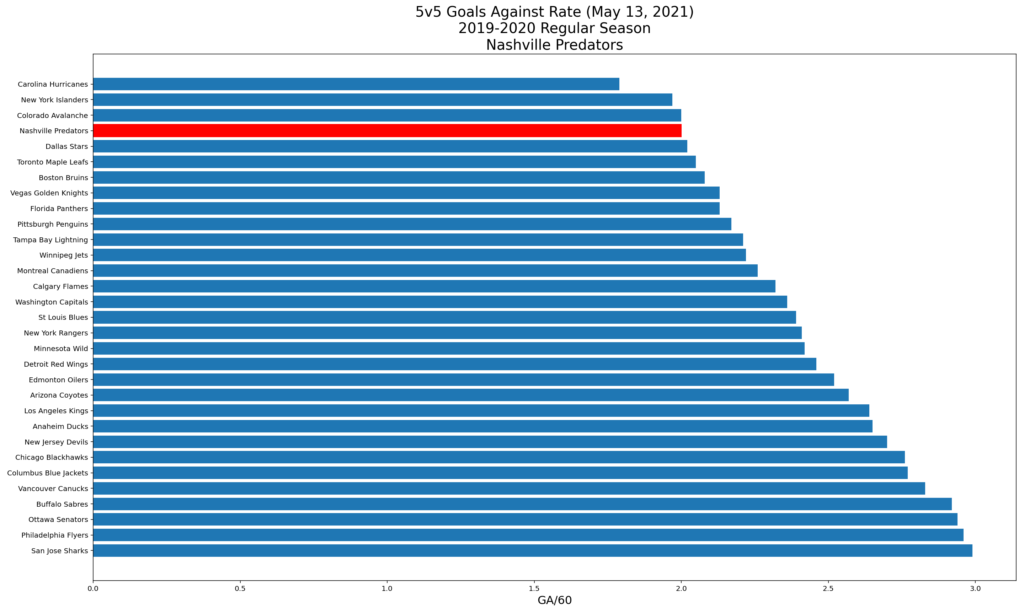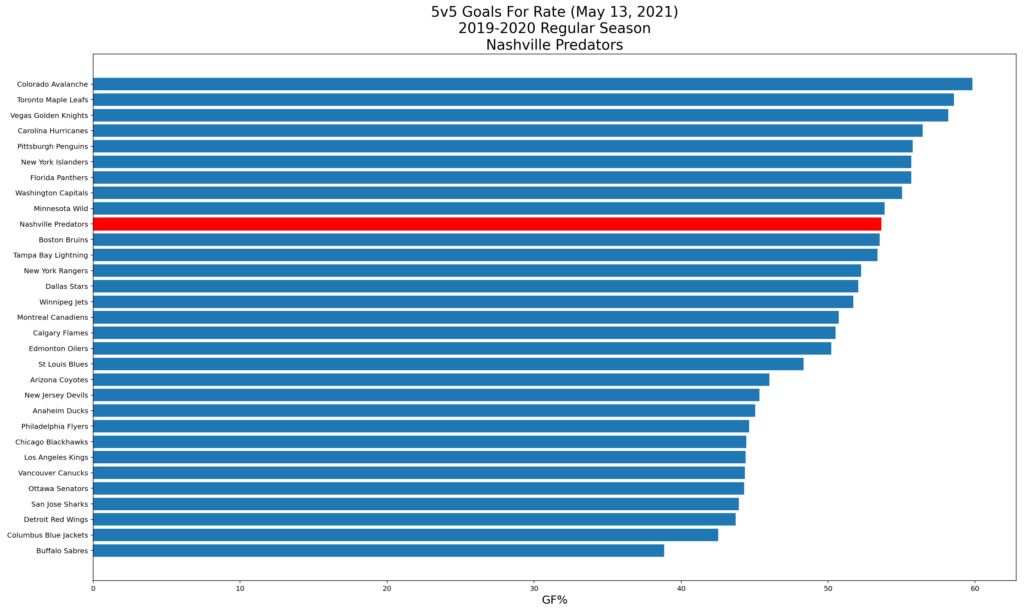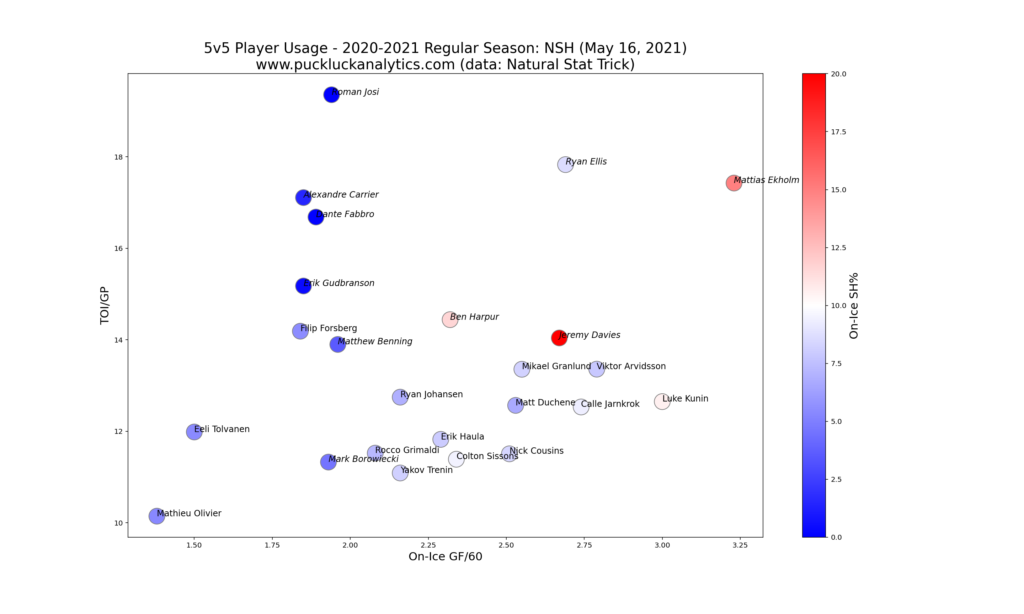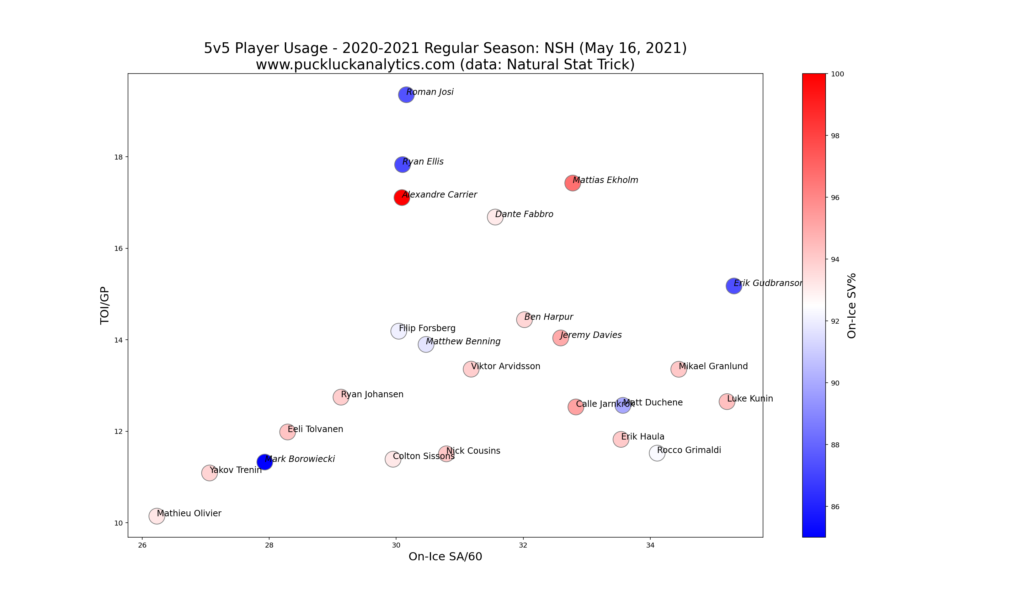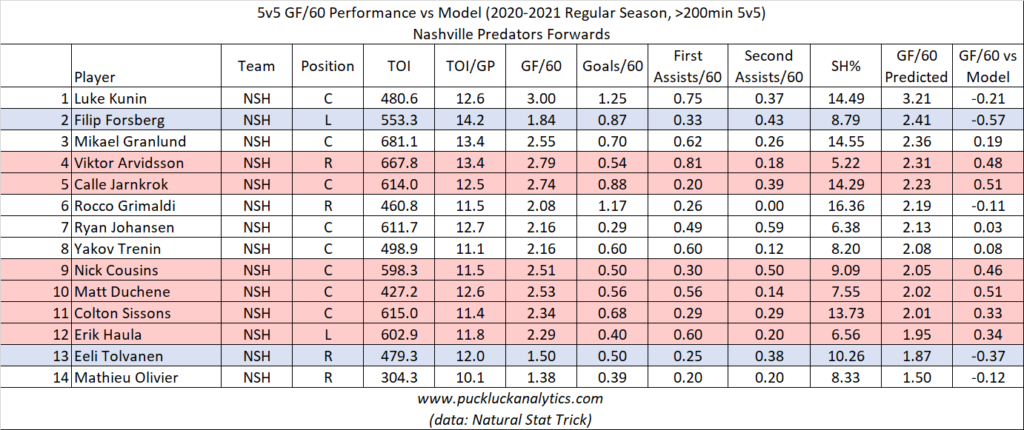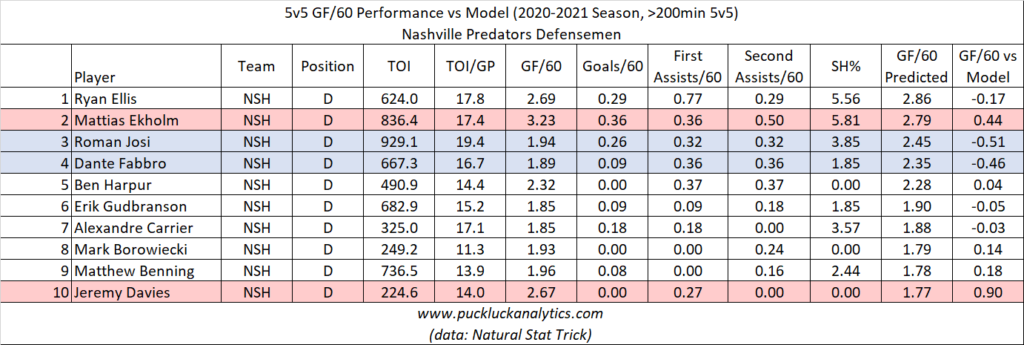The Nashville Predators struggled early in the 2020-2021 season and were widely to believed to be shopping some of their top players with an eye on a rebuild. A resurgence before the trade deadline saw them make a push into the playoffs instead, where they were dispatched in 6 games by the Carolina Hurricanes. As we dig into the Predators season, I encourage you to give this post a read for more detail on some of the plots we’ll look at.
Overall Performance (Regular Season)
We’ll start our review by looking at team level performance. We can use our points predictor model to understand how likely it is that the Predators’ results are repeatable based on their 5v5 results.
While the Preds finished the regular season in fourth place in the Central Division, our points predictor model actually puts them ahead of the Lightning in third spot. The model uses only 5v5 data and the fact that the Preds underperformed the model by a large margin suggests they are a better team than their final position in the standings indicates. Special teams results and overtime outcomes are the main causes of variance, and these factors can vary widely from season to season.
Let’s take a look at the Predators 5v5 goal rates that go into the model.
Looking at the goal rates, it’s clear where the Predators’ strength is. They were an elite defensive team in the regular season, sitting fourth in the NHL in 5v5 GA/60. While they struggled to score goals, they still ended up with a strong goal for percentage based on their strong defensive results.
Player Performance (Regular Season)
We’ll start digging into player performance by looking at a 5v5 player usage chart. By factoring defensemen’s stats, we get a visual depth chart along the diagonal from top right to bottom left.
Generally, we see Nashville’s top players at the top right of the chart and the players distributed nicely along a diagonal line indicating they were utilized effectively. The exceptions are Ryan Ellis, Mattias Ekholm, and Luke Kunin who fall well below the diagonal line. It looks as though they were under-utilized based on their individual point production.
Next, we’ll look at relative offensive impact by plotting on-ice GF/60 vs TOI/GP. This gives us a visual depiction of individual contributions to team GF/60. Players further to the top right had larger contributions.
We see Ellis and Ekholm stand out again on this chart, with strong offensive impacts. Among forwards, Filip Forsberg is an interesting case. While his individual point production showed him as one of the more effective Predator forwards in the previous chart, his on-ice GF/60 is one of the lowest on the team. We’ll look deeper into this further on.
We get a similar visual of individual defensive impact by looking at on-ice SA/60 vs TOI/GP. This time, stronger impacts are found further left and down on the plot.
We see Ellis has a relatively good defensive impact here, which further suggests he was under-utilized due to his strong offensive impact we saw in the last chart. Ekholm’s defensive impact is a bit worse, but not enough that it would fully negate the offensive impact we saw. There is quite a spread among the forwards and it’s interesting that most of the Preds’ players are over 30 SA/60, which is the league average. Clearly, Nashville’s strong 5v5 GA/60 was not due to limiting shot quantity.
To supplement the charts we’ve looked at, we’ll use our on-ice GF/60 models to look for signs that players carried their line mates. We do this by looking at the variance between the model output and the actual numbers. Variances greater than about 0.3 are noteworthy and negative variance suggests a player carrying his line mates.
Starting with forwards, we’ll jump back to look at Filip Forsberg again. We see that Forsberg appears to have had a strong positive impact on his line mates by his large negative variance from the model output. This may explain why we found him further left on the on-ice GF/60 chart than we expected. In essence, while his line mates benefit from playing with him, his overall offensive impact is dragged down as a result. The Predators could have benefitted by having some stronger offensive players to play with Forsberg.
There are also a large number of Predators forwards with significant positive variances, indicating they were carried by their line mates. For players with low shooting percentages, like Victor Arvidsson, the model prediction is likely too low, so the variance is less of a concern. However, most of these players have shooting percentages high enough this shouldn’t be a big factor.
Looking at defensemen, Roman Josi and Dante Fabbro stand out as having carried their line mates. We didn’t pick this up looking at the earlier charts and it helps to explain why we though Ellis and Ekholm appeared to be under-utilized. From this new information, it looks like Josi and Fabbro has stronger positive impacts than were perceptable in the initial charts. In addition, we see than Ekholm may have been carried by line mates offensively.
We saw earlier that the Predators were an elite defensive team at 5v5 despite not being strong at limiting shot quality. Looking at their goaltender’s numbers shows us why they were so strong defensively. Juuse Saros had a fantastic season, getting the majority the goaltending duties, and Pekka Rinne put up very competent numbers in a backup role.
Playoff Performance
While we cannot use a small six game sample to base any future projections on, we can use it gain some insight into what happened in the Predators short-lived playoff run. Let’s take a look at a 5v5 usage chart for the playoffs.
Ryan Ellis had a fantastic series offensively and we find him essentially off the chart. The rest of the Predators skaters are distributed fairly nicely in the diagonal pattern we expect over larger sample sizes, suggesting their top players came to play and the Predators had contributions from their depth players as well. In goal, Saros continued his strong play from the regular season as he put up a 0.933 save percentage at 5v5 over the 6 game series. All-in-all, the Predators appear to have played well but were beaten by a better team in a tightly contested series.
Looking Ahead
With under $65M committed to the salary cap for next season, the Predators have some flexibility to make some moves over the offseason.
Key RFAs:
The Preds have a handful of RFAs they need to deal with over the offseason. Dante Fabbro seems to be the most notable of the skaters. With signs that he carried his team mates offensively in our review, the Preds will be eager to get a deal worked out.
More notable than the skaters, Juuse Saros is also an RFA. With a very strong season that helped the Predators become one of the elite defensive teams this season, he will no doubt command a significant raise over his current $1.5M cap hit.
Key UFAs:
The Predators have a few skaters headed for unrestricted free agency, however none that seem to be key cogs for the team. As with the RFAs, the most notable UFA is in goal. Pekka Rinne’s deal is up and the Predators will have to think hard about whether they bring him back. With Saros’s cap hit likely to be significant, the Preds are likely to look for a low dollar deal for their backup. At age 38, Rinne poses some risk of a drop in performance but there may also be goaltending challenged teams out there that are willing to take a chance on him as a starter.
Key Players Under Contract:
Luke Kunin is under contract for another year at a $2.3M cap hit before he becomes an RFA. With signs of high offensive impact and possible under-utilization this season, the 23 year old could be a player that steps into a larger role to provide the Preds’ offense a boost while still on a reasonable cap hit.
Tough Questions:
Is it time for the Predators to start a rebuild, as was rumored early this season, or can the current core be competitive for a few more years? With a number of core players in their late 20s, there shouldn’t be a large drop in performance just yet. If the Predators can find a bit more offense, they may be able to re-tool on the fly.
Offseason Priority:
The Predators need a boost offensively. We saw that Forsberg carried his line mates and the Preds would benefit from finding him some more offensively talented line mates. Luke Kunin looks like a promising option but they need to add at least one more top six forward. The Preds also need to lock up Saros as the backbone of their defense.
Check out my other season reviews that are already up, such as the Florida Panthers and the St Louis Blues, and subscribe to catch the rest of my season reviews as they come out.
data: Natural Stat Trick
cap data: CapFriendly
